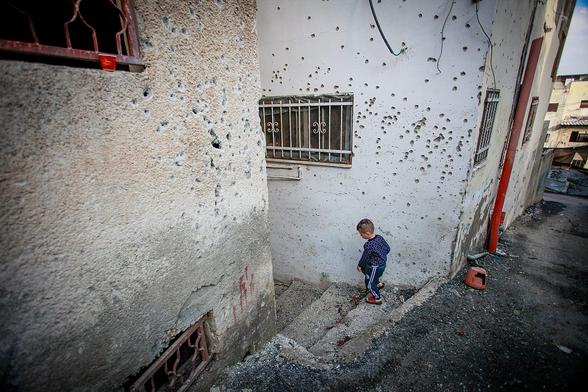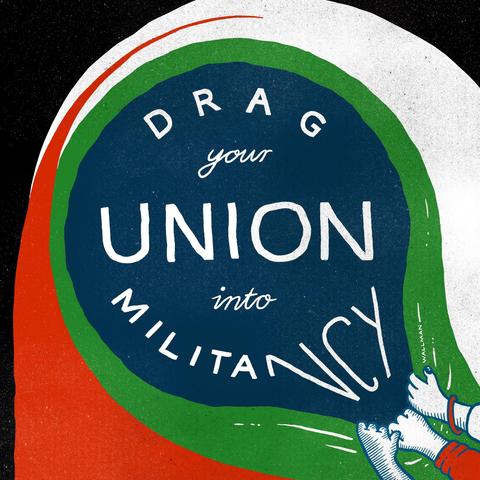Anarchists who want to take action, when confronted with the choice of tactics, often default to large mass actions, like black bloc. Imagination is ceded to tactical hegemony; autonomy diminishes; creativity recedes; resistance is franchised with stale, processed, prepackaged ideologies and tactics; questionable organizational methods like spokes-councils and democratic decision making give a participatory veneer to a sealed deal–just like in any liberal democracy; most participants spectate rather than act, learning by passive imitation of the leaders rather than active involvement in intimate relations with experienced trusted friends.
We hope to put an end to this stagnation by giving anarchists some ideas about tactical alternatives to large mass actions. Here we discuss Coordinated Attacks, an extension of single group clandestine actions to multiple groups operating in loose collaboration simultaneously. While the tactics discussed here are not new, we believe our analysis can help anarchists better understand their action options, avoid getting into a rut of the same old tired tactics, choose the option most suited to their objectives, and most importantly, be creative and experiment with new ways of acting.
Continua of Tactics
We propose some ways of comparing alternative tactics, such as single group clandestine actions, large mass actions, and calls to action, so as to aid selection among these tactics, and aid generation of new ones. Some important features that differentiate these tactics are
(i) Total group size. the total number of people participating in an action
(ii) Subgroup size. if there are subgroups, usually in the form of affinity groups, the number of people in the subgroups and whether they are too big, too small, or just right sized for their task
(iii) Timing. whether subgroups act simultaneously or asynchronously
(iv) Communication. whether the subgroups communicate with each other to coordinate prior to the action
(v) Complementarity. whether the subgroup actions complement each other
(vi) Dependency. whether the actions of subgroups depend on the actions of other subgroups
Complex Coordinated Terrorist Attacks
With the hope of expanding the reader’s tactical imagination, we draw on a type of tactic that is feared by the US government, and used by serious resistance movements across the world. Complex Coordinated Terrorist Attacks, so called by the US government, are tactics that use large groups composed of small coordinated subgroups that work simultaneously and complementarily, but have low or no dependency across subgroups during the action.
https://www.fema.gov/sites/default/files/2020-07/planning-considerations-complex-coordinated-terrorist-attacks.pdf
A complex coordinated terrorist attack works to complete some nefarious objective with smaller subgroups that each have a number of members right sized to their subtasks, usually act simultaneously to keep their opposition off balance and maximize impact, and communicate directly with each other prior to the action so as to act in ways that are complementary, or at least not work at cross purposes.
It is worth thinking about why the US government fears these tactics, and why groups that use these tactics rarely, or never, use large mass actions. Why is the US government afraid? Because these tactics are difficult to predict, prevent, and control once they’ve started. Why do these groups use complex coordinated terrorist attacks rather than large mass actions? Because they need to maximize their impact while minimizing risk. For this reason, they tend to only engage in open battle [large mass actions] when it is very likely to yield immediate surrender by the opposition. Look at the resistance movements in Afghanistan and Iraq over the last 20 or so years, and you’ll see extensive use of complex coordinated terrorist attacks, with large mobilizations only used as an end game tactic.
Why Coordinated Attacks?
While complex coordinated terrorist attacks with high degrees of complementarity are more aspirational given the current stages of development in the anarchist movement in the US, coordinated attacks, where the participant subgroups have similar objectives but involve less complex coordination, are highly feasible.
Coordinated attacks have several advantages over other tactics.
i. Because the overarching group has the same goal, but not necessarily the same targets, the total group size can be arbitrarily large. This prevents situations where only one target is chosen, so only a few people can participate, or where many people want to participate, but there are not enough targets for them to all contribute to the action.
ii. Subgroups can be autonomously sized and organized to do specific tasks rather than being subsumed into a large mass with unclear objectives and an implicit leadership hierarchy. Each subgroup makes and executes their own plan within the framework of the agreed upon time and objectives.
iii. Simultaneity increases the shock factor, potential impacts, as well as reduces risks by spreading law enforcement thin.
iv. Prior communication between the subgroups allows for the coordination of timing, selection of common objectives, avoidance of target overlap, and minimization of risk to other subgroups, for example by accidentally leading the police into another subgroup.
v. Coordinated attacks have complementarity without dependency. An advantage of having low dependency is that if a subgroup decides to not participate or if a subgroup fails in their task, the other subgroups, who are not highly dependent on each other, can still do their part of the action. Although we do not emphasize high levels of dependency here–which would make the action significantly more complex–there is the possibility for actions to complement each other, for example by clearing contiguous parts of a travel corridor of surveillance cameras.
Comparison of Coordinated Attacks to Other Tactics
How do coordinated attacks compare to single group clandestine actions, large mass actions, calls to action, and complex coordinated terrorist attacks? Here we distinguish three dimensions that may be useful for this comparison.
Direct effects of the action. How much damage was done? Was the target taken out?
A direct effect might be a police vehicle disabled, a surveillance camera destroyed, or enemy communication disrupted.
Risks of the action. Will people get caught? Will information be revealed to law enforcement?
This considers the number of action participants caught by law enforcement, as well as the chances of getting caught. Information revelation might be whether an infiltration route to a target is made known to the opposition.
Indirect effects of the action. How do participants learn to relate to each other? How are observers inspired and encouraged, or paralyzed with fear?
Are action participants following the leader or are they taking initiative to construct the action themselves by actively choosing targets, crafting infiltration and exfiltration routes, and agreeing on proper roles for the subgroup individuals? Are observers inspired by the action because of its high impact and low risk, or are observers fearful after the action because participants got caught?
As shown in the table, we believe that coordinated attacks compare favorably to other tactics across these three dimensions.
TacticDirect EffectsRisksIndirect EffectsCoordinated
AttacksPotential for damage or destruction of multiple targetsGreater risk than single group clandestine actions due to communication between subgroups about timing and targets; smaller risk than call to action due to simultaneous actions spreading law enforcement thinSubgroups learn to act independently as well as coordinate; encourages initiative of each subgroup participant; no hierarchy; can encourage observers if well executedSingle Group Clandestine ActionsPotential for damage or destruction of one targetLowest risk due to high levels of skill and affinity between group members; low risk of information leak about timing and targetsGroup participants have initiative but do not learn to coordinate with other groups; actions often go unrecognized by observersLarge Mass ActionsPotential for large damage at one target or small damage because of redundancyGreater risk due to many participants in a single areaParticipants do not necessarily have initiative; will look to leaders; creates an implicit hierarchy; can be spectacular to observersCall to ActionPotential for large damage at multiple targets or no damage if all subgroups pull outRisk not much greater than single group clandestine actions due to lack of communication about timing and targetsEach subgroup has initiative but does not learn to coordinate with other subgroupsComplex Coordinated Terrorist AttacksPotential for large damage at multiple targetsRisk of infiltration or information leak greater than other tacticsSame as coordinated attacks, but subgroups learn more intricate coordination
Comparison of direct effects. Coordinated attacks have the potential to hit multiple targets and do large amounts of damage to each target. This damage could be greater than a single group clandestine action, due to the greater number of participants; greater than a large mass action, because the subgroups avoid redundancy by focusing on specific discrete targets; and greater than a call to action because of the tendency for communication between subgroups to increase follow through and impact. Complex coordinated terrorist attacks are likely to have the greatest direct effects.
Comparison of risks. Single group clandestine actions are likely to have the lowest risk because of the small chance for information leak and small number of participants that need to exfiltrate the target area. When there are more subgroups and more total participants, there is a greater chance of someone being an infiltrator or unintentionally leaking information. Coordinated attacks and complex coordinated terrorist attacks have an advantage due to simultaneity, where subgroups, if located in a similar geography, could spread law enforcement thin, lowering the overall risk to each subgroup. Large mass actions have the greatest risk because it is difficult to exfiltrate many participants in the same area, participants tend to rely on organizers and as a result are often not as well prepared, hampering their exfiltration, and large numbers of people in a single area attract law enforcement attention and thus greater repression.
Comparison of indirect effects. Complex coordinated terrorist attacks require the largest amount of collaboration, coordination, and inititative from the individual participants and subgroups, fostering the creation of a superb type of anarchist and militant. Coordinated attacks follow closely behind, lacking some of the complexity and complementarity. Single group clandestine actions and calls to action yield similar results: small groups with high levels of initiative but no coordination across groups. Finally, large mass actions lead to the creation of many individuals who get used to following the leader, but due to their size and visibility, large mass actions are often inspiring to observers.
Some Drawbacks of Coordinated Attacks
The main drawback of coordinated attacks relative to single group clandestine actions and large mass actions is the difficulty of planning. It is often challenging to find other affinity groups who are willing to participate. These subgroups may not have the skills and resources necessary to plan and act on their own. Without a larger group for support or detailed guidance from experienced people, some might have second thoughts and decide to opt out. For this reason, coordinated attacks can easily devolve into a single group action. Calls to action have a similar problem, where it is even possible for no groups to take action in response to the call. Single group clandestine actions only require a single dedicated group of individuals, and large mass actions and calls to action only require the leaders or organizers to be coordinated.
Another drawback relative to large mass actions is that, for some targets, a large number of people are needed to overwhelm law enforcement. It may be possible, however, to use a coordinated attack approach to overwhelm a target’s defenses, where each subgroup focuses on a single target with well-defined roles. Such a coordinated approach requires significantly more planning, and creates dependency between the outcomes of each subgroup, where if one fails–for example, to take out surveillance–another can also fail–by getting surveilled and then being intercepted by law enforcement.
Mitigating Risk
Single group clandestine actions have the lowest risk because group participants tightly control information. Everything is communicated on a need-to-know basis, and those outside the group don’t need to know anything about who is participating, when the action will happen, and the location of the target.
The most important way to mitigate the risk of information being leaked outside the action group is affinity between subgroups. When subgroups know each other, have close ties, have done actions together before, and have a track record of keeping their mouths shut, risks of information being leaked to law enforcement with multiple subgroups are not much larger than risks with a single group.
When building these close ties and executing actions, subgroups might use some of the following methods to mitigate information flow risks. [a] having some sort of vetting and vouching method before talks between subgroups begin–usually this happens informally and casually, [b] working together on small, lower risk actions before trying riskier actions together, [c] communicating in person with only a few members from each subgroup to mask the identity of all the group members, [d] revealing the action timing only immediately beforehand, [e] developing a list of regions within the same law enforcement zone for target selection, without the exact targets specified.
With respect to the last method, planners might work together to divide a single law enforcement zone into regions, with each region containing multiple possible targets that support the same goal. A slip of paper is passed around the planning group with a few of the regions already crossed out to mask who selected the first region. Subgroups sequentially cross out regions that they would like to pick for themselves. At the end, no subgroup member can tell which other subgroup chose which region, and in turn, they cannot tell which subgroup chose which target within each region. This is just one idea. Come up with better ones.
Surveillance Cameras as Small, Lower Risk Actions to Build Affinity
All these tricks and techniques for mitigating risk don’t matter if you don’t have close, trustworthy ties with at least one other affinity group. As a starting point, we recommend taking the first step of developing those ties, even to one other affinity group, rather than developing complex methods for controlling information flow to mitigate risk. In the end, the overall risk to a group is determined by the weakest link, so be picky with your affiliations.
Developing trust within and across affinity groups requires background knowledge about each other acquired through social relationships, time to get to know each other and observe each others’ actions, and acting together in lower risk contexts. Every individual and group should take action based on their individual and group desires.
One suggestion that has proved useful in the past is destroying surveillance cameras together. This has the effect of teaching participants about scouting, infiltration and exfiltration routes, proper clothing attire, lookouts, use of police scanners, and police response timing. Possibly more important, participants learn that law enforcement is not omniscient and omnipotent, that cameras are often highly directional and often get no footage or useless footage, and that cameras are often not replaced, meaning the damage is permanent. A final obvious practical benefit is that there are fewer cameras around, increasing freedom of action.
An Example
Consider the following hypothetical example. A region has multiple entities that support something awful, like a fossil fuel pipeline or Israeli weapons manufacturing. Entities could include funders, providers of logistics, insurers, or other supporting infrastructure. Through whisper networks, DMs with disappearing messages, and in-person conversations, a number of affinity groups come together to discuss an action in person, away from buildings, and without phones. At least some members of each affinity group have close ties to each other, with prior experience in many contexts that indicate trustworthiness. Each subgroup sends a few people to the discussion.
For the pipeline case, the pipeline construction area spans many hundreds of miles, with various targets, such as construction equipment, temporary housing, and transportation vehicles. The area is the jurisdiction of state police. The group divides the area into 15 regions–the number 15 here is chosen arbitrarily–each with multiple possible targets. Suppose there are 5 affinity subgroups. The planning group passes around a ballot with the 15 regions listed, five of them already crossed out. Each subgroup crosses out a region in sequence until all of the regions are eliminated. Each subgroup commits to only going after targets within one of the two regions that they crossed out. Other subgroups then only have imprecise knowledge of which subgroup selected which region, and know very little about target selection. [A simpler method: Write numbers corresponding to the 15 regions on 15 playing cards, then allocate them randomly to subgroups.]
The subgroups agree on a date after which they will all be prepared to act, but delay choosing an exact time. After the preparation date has passed, they call a meeting, where the final time is chosen, possibly with very little advance notice–hours rather than days. After the action, communiques are written and contact between participants is avoided until some time has passed. The participants never talk about the action again, although they continue to collaborate if trust has been furthered through the action, and mouths are kept shut.
A Note on Group Size
The focus here has been on an alternative tactic for actions with a large number of people. However, more people does not equal better. Even a single individual can pull off complex, highly effective tasks with low risk. For an apolitical example, see Bill Mason’s Confession of a Master Jewel Thief. For political examples, see some recent raids on Elbit Systems suppliers. Focus, reconnaisance, careful target selection, and precision can do much more than number of bodies.
Endnote
We don’t care if you use coordinated attacks or any other tactic. What we care about is breaking the tactical hegemony, fostering creativity and new affinities, and keeping people safe while having some fun. We hope this essay builds new ideas and relationships rather than stifles and straight-jackets you into a new, different, hegemonic tactical regime.
Explore.
Experiment.
Follow no leader and no rules.
Originally Published On Unravel
secondary source: Scenes
https://abolitionmedia.noblogs.org/post/2024/08/02/from-a-matter-of-principle-to-a-matter-of-tactics/
#anarchism #clandestine #DirectAction #militancy #northAmerica


